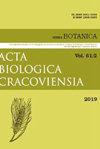水杨酸缓解盐胁迫对番茄植株的不利影响显示出一种时间特异性和器官特异性的抗氧化反应
IF 0.5
4区 生物学
Q4 PLANT SCIENCES
引用次数: 44
摘要
关于外源水杨酸(SA)是否能通过诱导抗氧化反应来提高栽培植物的耐盐性,近十年来发表了相互矛盾的结果。只有高浓度SA (~10-4 M)处理才能减轻番茄的盐胁迫伤害,低浓度SA处理效果不明显。众所周知,Na+在老叶片中的有效积累是番茄植株(Solanum lycopersicum cv。但在10-7 M或10-4 M SA硬化后,幼叶和老叶或根组织在盐胁迫下是否具有明显的抗氧化状态仍未得到充分研究。对超氧化物歧化酶(SOD)和过氧化氢酶(CAT)活性的测定表明,盐诱导的幼苗叶片和/或根组织中超氧化物歧化酶(SOD)和过氧化氢酶(CAT)活性的短暂升高与植物的耐盐性无关。盐胁迫导致幼叶抗坏血酸过氧化物酶(APX)活性增加10倍,10-4 M SA硬化根APX和谷胱甘肽还原酶(GR)活性显著增加。总抗坏血酸(AsA)和谷胱甘肽库在10 ~ 7 M SA预处理后均达到最高水平。然而,与叶片相比,盐胁迫下根的AsA总库减少,因此,由于APX活性低,抗坏血酸在这些组织中非酶清除活性氧。在高盐条件下,10-4 M SA处理后植株根系GR活性增加,使还原性谷胱甘肽(GSH)库增强,维持AsA的氧化还原状态,从而提高耐盐性。本文章由计算机程序翻译,如有差异,请以英文原文为准。
The Alleviation of the Adverse Effects of Salt Stress in the Tomato Plant by Salicylic Acid Shows A Time- and Organ-Specific Antioxidant Response
In the last decade contradictory results have been published as to whether exogenous salicylic acid (SA) can increase salt stress tolerance in cultivated plants by inducing an antioxidant response. Salt stress injury in tomato was mitigated only in cases when the plant was hardened with a high concentration of SA (~10-4 M), low concentrations were ineffective. An efficient accumulation of Na+ in older leaves is a well-known response to salt stress in tomato plants (Solanum lycopersicum cv. Rio fuego) but it remains largely unexplored whether young and old leaves or root tissues have a distinct antioxidant status during salt stress after hardening with 10-7 M or 10-4 M SA. The determination of superoxide dismutase (SOD) and catalase (CAT) activity revealed that the SAinduced transient increases in these enzyme activities in young leaf and/or root tissues did not correlate with the salt tolerance of plants. Salt stress resulted in a tenfold increase in ascorbate peroxidase (APX) activities of young leaves and significant increases in APX and glutathione reductase (GR) activities of the roots hardened with 10-4 M SA. Both total ascorbate (AsA) and glutathione pools reached their highest levels in leaves after 10-7 M SA pre-treatment. However, in contrast to the leaves, the total pool of AsA decreased in the roots under salt stress and thus, due to low APX activity, active oxygen species were scavenged by ascorbate non-enzymatically in these tissues. The increased GR activities in the roots after treatment with 10-4 M SA enabled plants to enhance the reduced glutathione (GSH) pool and maintain the redox status of AsA under high salinity, which led to increased salt tolerance.
求助全文
通过发布文献求助,成功后即可免费获取论文全文。
去求助
来源期刊
CiteScore
3.00
自引率
0.00%
发文量
0
审稿时长
>12 weeks
期刊介绍:
ACTA BIOLOGICA CRACOVIENSIA Series Botanica is an English-language journal founded in 1958, devoted to plant anatomy and morphology, cytology, genetics, embryology, tissue culture, physiology, biochemistry, biosystematics, molecular phylogenetics and phylogeography, as well as phytochemistry. It is published twice a year.

 求助内容:
求助内容: 应助结果提醒方式:
应助结果提醒方式:


